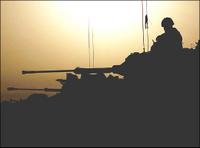 British forces have suffered approximately one thousand casualties since the invasion of Iraq and the total is likely to keep increasing as the conflict intensifies.
British forces have suffered approximately one thousand casualties since the invasion of Iraq and the total is likely to keep increasing as the conflict intensifies.With the sad news of two more deaths of British soldiers earlier this week and another today, it may be time to ask again about the true cost of the Iraq war - this time to the British people. A simple answer is available you might think, but actually it is next to impossible to find the true number of British casualties.
The reason is that the government and Ministry of Defense, unlike their American counterparts, do not willingly issue any information on the large number of wounded UK personel. These hidden casualties include people who have lost limbs and had their lives permanently shattered but, because they survived, their loss receives no public recognition.
The large discrepancy between published and actual casualties became clear to me at the start of this year when I, along with others, wrote to the MOD to request information under the new freedom of information act.
The reply from the MOD revealed that while 85 fatalities had occurred by that time, 790 other troops had been seriously wounded. They would not provide information on the extent of the injuries or even how they received them so some doubt remains. However, these were people who had to be evacuated form Iraq as a result of their condition so one has to assume that they were seriously hurt.
The wounded to dead ratio for the British forces during the Iraq conflict of 9.3 is similar to that for the US. A study in the New England Journal of Medicine from December last year revealed that for every 10 US casualties only one died, despite the lethality of the weapons employed. They comment that:
"Though firepower has increased, lethality has decreased. In World War II, 30 percent of the Americans injured in combat died. In Vietnam, the proportion dropped to 24 percent. In the war in Iraq and Afghanistan, about 10 percent of those injured have died. At least as many U.S. soldiers have been injured in combat in this war as in the Revolutionary War, the War of 1812, or the first five years of the Vietnam conflict, from 1961 through 1965. This can no longer be described as a small or contained conflict. But a far larger proportion of soldiers are surviving their injuries. Because of the improvements in medical practice soldiers are surviving injures in the Iraq war that would of killed them in Vietnam or even other more recent conflicts. The high ratio of wounded to dead is largely accounted for by these advises in technology and proactie, but, this results in people surviving with horrific disabilities including multiple limb losses and other impairments."
While such a study has not been performed in the UK one can assume that the situation is similar even though UK troops have not been involved in the sort of intense urban conflict that the US has under taken in Falluja and elsewhere.
Therefore, it is probable that the true UK casualty situation is as follows:
From the invasion in March 2003 to January 10th 2005, MOD figures tell us that there were at least 875 casualties of which 85 died and 790 were seriously injured.
Since that date we know that eleven more soldiers have been killed. Based on the previous ratio we can estimate that 102 troops have also been seriously wounded giving a total for the period of 113 and a overall estimated figure for total casualties since the war began of 988.
Why is it that the UK government, unlike the Americans, refuse to issue the full casualty figures for British forces serving in Iraq? And why does the mainstream media allow the perpetuation of this distortion of the real situation?
An obvious reason is that if the true casualty figures were circulated the British public would gain quite a different picture of the ongoing conflict, the extent of our involvement in the fighting, the somewhat cozy image that we have of the British role in the Iraq operation. While such a position may provide some, unfortunately, false comfort to the families of those serving in Iraq, it fails to acknowledge the full price being paid by our young men and women and the full cost to our armed forces of Mr Blair's decision to join the US led invasion. With violence increasing in Southern Iraq as the insurgency becomes more active in the area, it is likely that the direct involvement of British troops and the resulting casualty toll will increase still further.
Update: From June 2007 we are tracking current data on British casualties as it is released. For the latest see the British Casualty Monitor page.